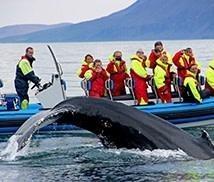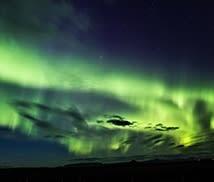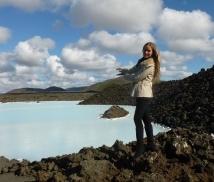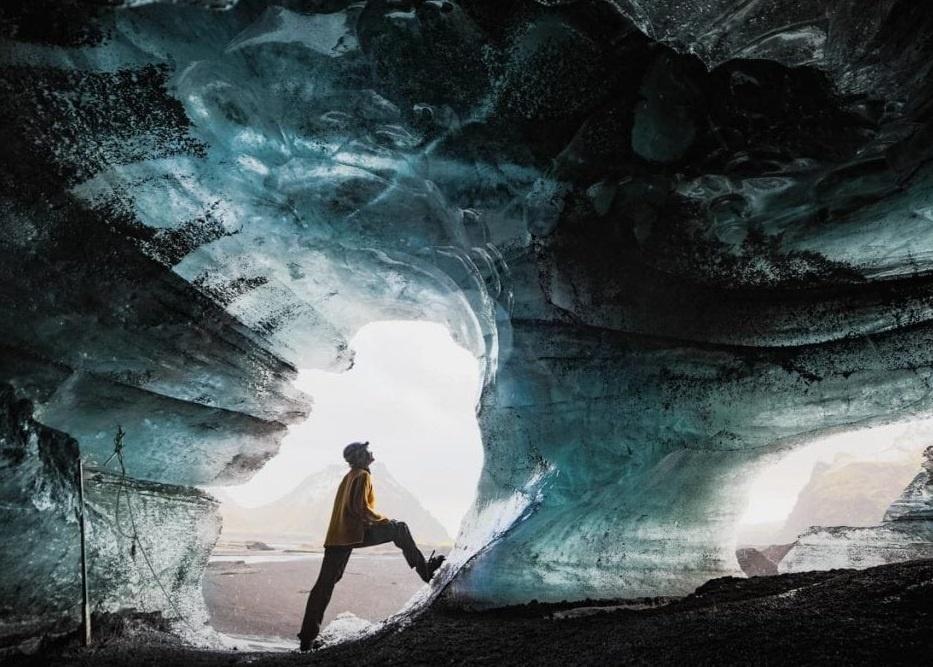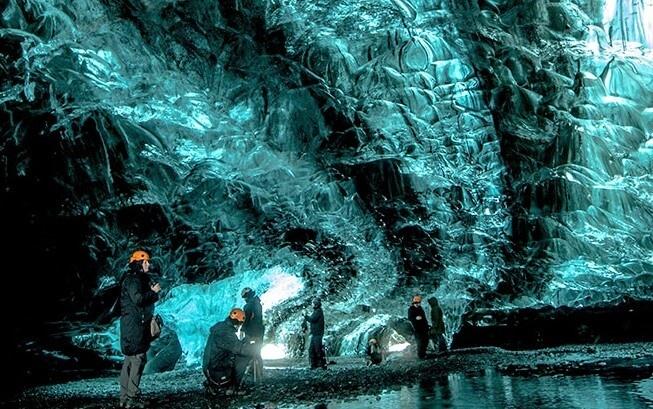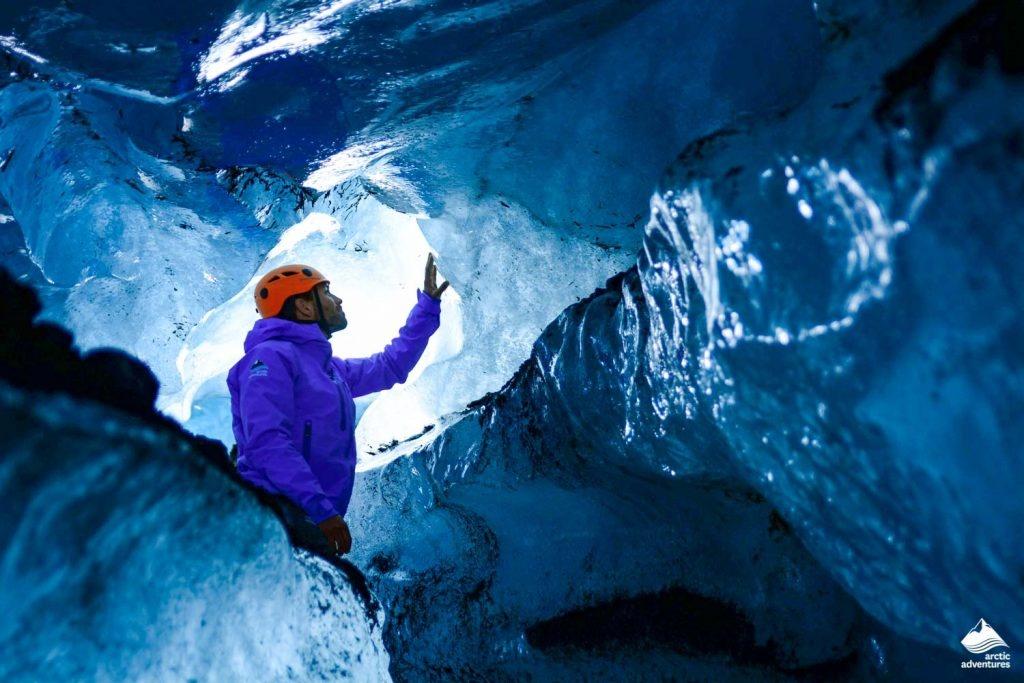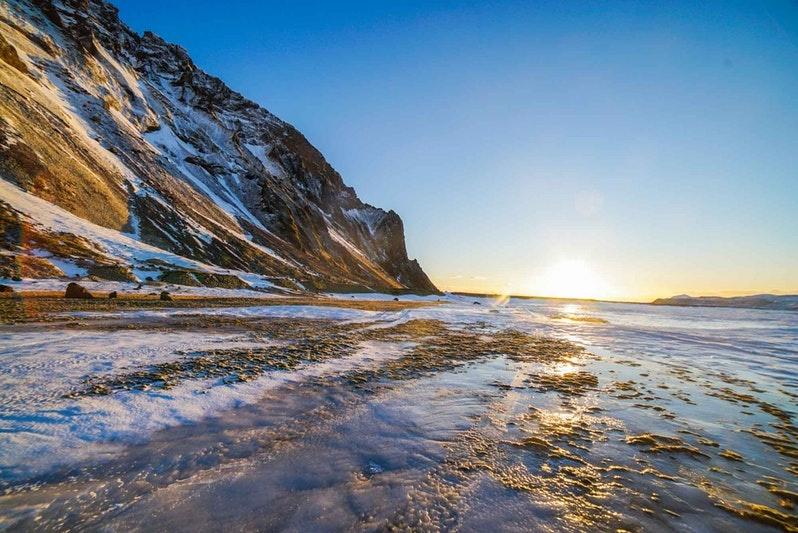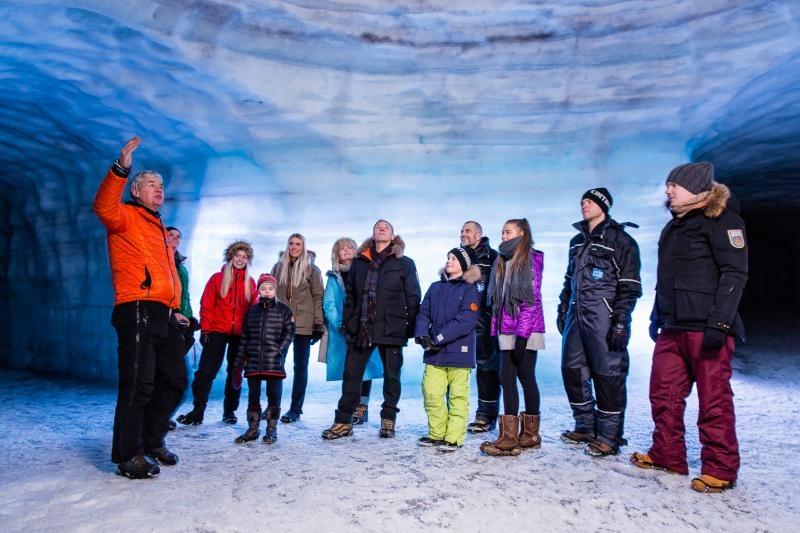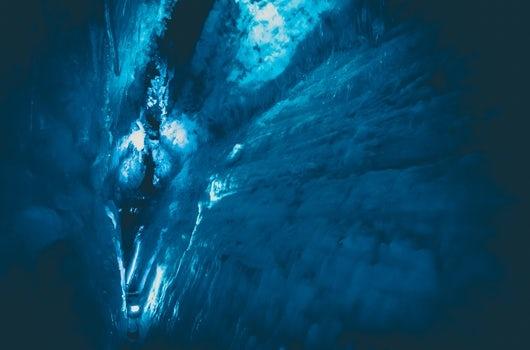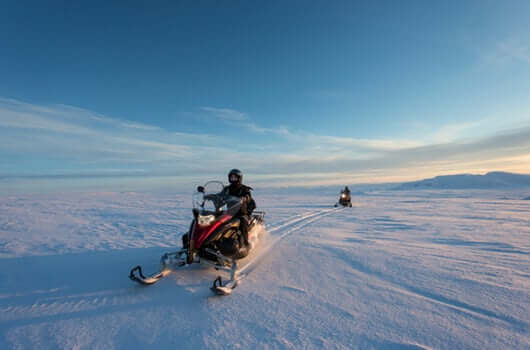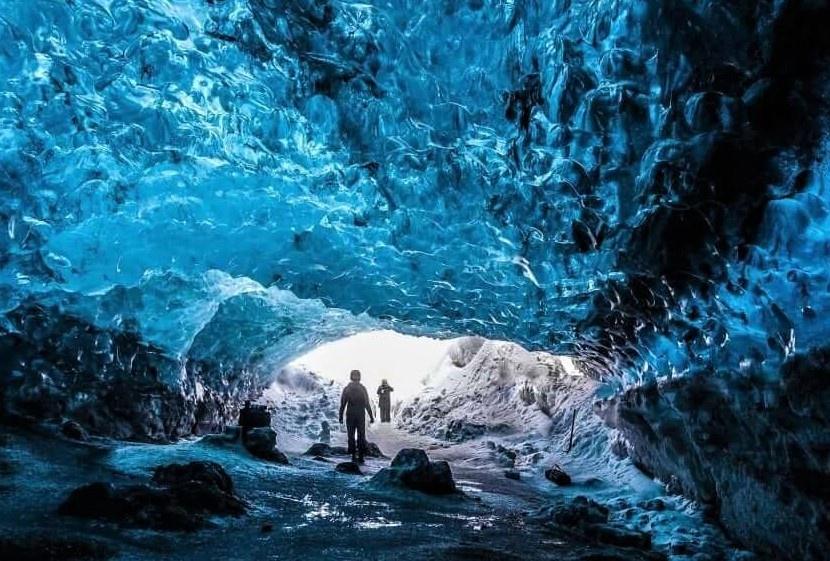ICE CAVE TOURS IN ICELAND
Don't stay on the surface, enter one of the many amazing ice caves in Iceland. The colours of the bright ice and the interior of the glacier will blow your mind. You can choose between the incredible ice caves at Vatnajökull glacier, the ice cave under Katla volcano or the ice tunnel at Langjökull, among others.
- What is an ice cave and how is it formed?
- The ice caves are caves that are formed inside the ice of a glacier. Although the correct name would be "glacier caves" as ice caves can be found somewhere else, all the people who come to Iceland know them simply as ice caves and that's why we name them like this. The water, which often comes from the glacier's surface due to the melting ice, enters the ice through a glacier mill and leaves the glacier's snout downward. The heat transfer from the water causes enough melting to create a cavity inside the ice filled with air. Afterwards, the movement of the air causes the expansion of the caves. Another reason these ice caves or glacier caves are formed is the geothermal heat from hot springs under the ice or volcanic vents. Many of the ice caves that are visited can be relatively unstable, so it is recommended to take precautions and it is only possible to visit them on guided tours accompanied by expert guides. The instability is due to meteorological conditions, temperature change and the glacier constant glacier movement. That's why the ice caves can appear and disappear each year and most of them are only possible to see during the winter months, from November to March.
- What are the colour of the ice caves in Iceland?
- You have probably already seen the pictures of the amazing blue colour of the ice caves in Iceland. These pictures were taken from the cave named as "Crystal Ice Cave" and the brilliant blue colours are a result of the compression of snow into ice. The ice is so thick, dense and old that it absorbs all colours of the spectrum except the blue, so that's the colour we see. But the glaciers are in continuous movement, every year different caves are formed and although the guides look for the best ones it is possible that the colour of the cave you are entering may look a bit different. The colour is normally mixed with the colors of the cave itself, which can be gray, black, brown. Therefore you can see many different colours in an ice cave and they are all great. Each cave has one-of-a-kind features and can have different size or colour.
- How many ice caves are in Iceland and in which glaciers can I find them?
- It is not possible to know how many ice caves are in Iceland (more than 10% of the Iceland is covered by ice) but here is the list of the main glaciers in Iceland where you can enter an ice cave (remember that you need to book a guided tour in advance as the ice caves in Iceland are dangerous to visit on your own):
- Vatnajökull glacier and the Crystal ice cave: Of course, the largest glacier in Europe is also the favourite one when it's come to ice caves. Most ice caves tours depart from Jökulsárlón glacier lagoon or Skaftafell national park, both at Vatnajökull area. The most famous tour is the ice cave tour at Vatnajökull, known also as the Crystal Blue Ice Cave tour, which departs from Jökulsárlón glacier lagoon and usually goes for the most spectacular cave at the glacier. On the other hand, the ice caves that are seen from Skaftafell National Park are normally combined with glacier hikes. It is more accurate to name these ice caves ice coves or glacier caves. They are formed by the glacier river that runs through the glacier in the summer. For this reason, these ice caves can only be found in the winter when the water has frozen. If you are planning to enter an ice cave at Vatnajökull glacier you have to book a tour in advance. Click on the pictures above, choose your favourite and remember that is only possible to visit between November and March, if the weather allows it.
Mýrdalsjökull glacier and the ice cave under the volcano: Mýrdalsjökull glacier is the fourth largest glacier in Icelandl and is located in South Coast Iceland, so it is accesible from Reykjavík in a one-day tour. In the Kötlujökull Glacier tongue it is hidden the famous Katla ice cave, named after Katla volcano. This ice cave under the volcano has traces of past eruptions and the colour here is less brilliant, with blue and black ice walls dotted with bubbles. There are two great advantage to this ice cave, one is that is possible to book a tour from Reykjavík and the other one is that it is possible to enter this ice cave throughout the whole year. So if you come during summer months, this is definitely your best option.
Langjökull glacier and the ice tunnel: In the second largest glacier in Iceland it is possible to enter the world's largest man-made ice tunnel. There are actually two main activities that can be done on Langjökull Glacier: a snowmobile tour and a guided tour in the ice tunnel. On the ice tunnel tour you will first go in a specially modified vehicle to be able to cross the glacier. In addition, you can combine both activities, snowmobiles and the visit to the ice tunnel to explore the entire glacier in the best possible way. Although this is not a natural glacier ice cave, it is really impressive, there is no age limit and it is possible to see it throughout the entire year. For those who are more interested in natural ice caves, some of them have recently appear in this glacier and tours are offered combined with snowmobile ride. The ceiling of the cave is reminiscent of a bright blue river surrounded by white ice, which turns a very unusual gray due to layers of ash from various volcanic eruptions. Both tours are also available with departure from Reykjavík.- What can I do in the glacier in Iceland apart from an ice cave tour?
-
To make the most of the day you can combined the ice cave tour with different activities, such us a snowmobile tour, a hiking tour on the glacier or the boat tour on Jökulsárlón glacier lagoon. It will depend on the ice cave tour you are taking, the availability and your travel plans. There are already some combined tours offered like the "Glacier Hike and Ice Cave" at Vatnajökull glacier or the "Snowmobiles and Ice cave" at Langjökull glacier but you can also book different tours for the same day as long as the schedules fit. If you have any question, we are here to organize the best trip to Iceland!
Can I visit the ice caves in Iceland staying in Reykjavík?
Yes, from Reykjavík there is a day tour to the ice cave under the volcano (at Mýrdalsjökull glacier in South Iceland), to the ice tunnel at Langjökull glacier or with snowmobile and to the ice cave (also at Langjökull). If you want to visit the ice caves at Vatnajökull, you need at least two days from Reykjavík. If you are travelling on your own you can book the tours from Skaftafell or Jökulsárlón glacier lagoon. If you are staying in Reykjavík we recommend you to book the fabulous 2 days South Coast tour, which includes the visit to the ice cave and one night in South Coast Iceland.What is included in an ice cave tour in Iceland?
The ice cave tours in Iceland always include an English speaking expert guide and the transfers from the pick up point to the ice cave, sometimes in Super Jeeps or even in special modified vehicles to be able to cross the glacier. All the necessary equipment to enter the ice caves is also provided. Remember that Iceland is always quite cold and the glacier brings colder temperatures, so please be sure to pack and dress accordingly. This includes waterproof and windproof jackets, pants and boots, with several layers underneath too, as well as hats, mittens, gloves, scarves, sunglasses and cameras.When can I visit an ice cave in Iceland?
Ice cave tours at Vatnajökull Glacier are only available between November and March. The ice cave under Katla volcano at Mýrdalsjökull glacier runs the whole year as well as the tours on Langjökull glacier. Check the reservation panel to see the dates and choose the one that fits you more. The ice caves in Iceland are a once in a lifetime experience.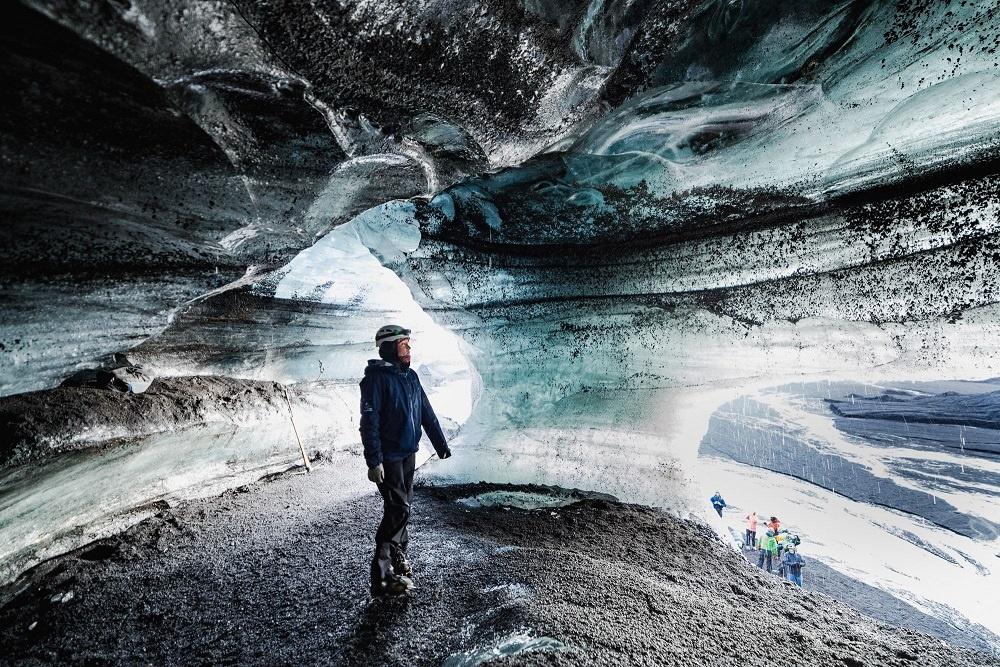
Ice cave tours are a popular and unique way to explore Iceland's stunning natural beauty during the winter months. Iceland is home to several glaciers, and as the ice shifts and melts, it creates stunning ice caves that visitors can explore.
Here are some things to know about ice cave tours in Iceland:
-
When to Go: Ice cave tours are typically offered from November to March, when the temperatures are cold enough for the ice to form and the caves are stable enough to explore. However, the exact timing can vary depending on weather conditions and other factors.
-
Tour Options: There are several companies that offer ice cave tours in Iceland, and they typically depart from Reykjavik or nearby towns. Tours can range from short, easy hikes to longer, more challenging treks, and can include transportation, equipment, and a guide.
-
Safety Precautions: Ice cave tours can be physically demanding, and visitors should be prepared for cold and wet conditions. It's important to wear warm, waterproof clothing and sturdy shoes, and to follow the instructions of the guide at all times.
-
Unique Experience: Ice caves are a unique and stunning natural phenomenon, and exploring them is a once-in-a-lifetime experience. Visitors can marvel at the blue and white colors of the ice, and learn about the geology and history of the glaciers from their knowledgeable guide.
-
Sustainability: It's important to choose a tour operator that prioritizes sustainability and environmental responsibility when exploring the ice caves. Visitors should respect the fragile environment of the caves and pack out any trash or waste.
Overall, ice cave tours in Iceland are a must-see for nature lovers and outdoor enthusiasts. With the right gear and a sense of adventure, visitors can explore the beauty and wonder of Iceland's glaciers in a truly unforgettable way.
Pictures from the Ice cave tours in Iceland:
Important note: All activities in the Icelandic nature are carried out under the own responsibility of the clients. ISLANDICA s.r.o. is not responsible for any accidents that may occur during the activities or due to the actions of the participants. The people who participate in these outings are accepting these conditions when booking a tour. ID 839.

 ES
ES  EN
EN 

